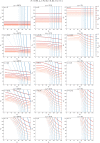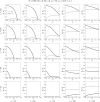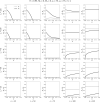Predictions from standard epidemiological models of consequences of segregating and isolating vulnerable people into care facilities
- PMID: 37903148
- PMCID: PMC10615287
- DOI: 10.1371/journal.pone.0293556
Predictions from standard epidemiological models of consequences of segregating and isolating vulnerable people into care facilities
Abstract
Objectives: Since the declaration of the COVID-19 pandemic, many governments have imposed policies to reduce contacts between people who are presumed to be particularly vulnerable to dying from respiratory illnesses and the rest of the population. These policies typically address vulnerable individuals concentrated in centralized care facilities and entail limiting social contacts with visitors, staff members, and other care home residents. We use a standard epidemiological model to investigate the impact of such circumstances on the predicted infectious disease attack rates, for interacting robust and vulnerable populations.
Methods: We implement a general susceptible-infectious-recovered (SIR) compartmental model with two populations: robust and vulnerable. The key model parameters are the per-individual frequencies of within-group (robust-robust and vulnerable-vulnerable) and between-group (robust-vulnerable and vulnerable-robust) infectious-susceptible contacts and the recovery times of individuals in the two groups, which can be significantly longer for vulnerable people.
Results: Across a large range of possible model parameters including degrees of segregation versus intermingling of vulnerable and robust individuals, we find that concentrating the most vulnerable into centralized care facilities virtually always increases the infectious disease attack rate in the vulnerable group, without significant benefit to the robust group.
Conclusions: Isolated care homes of vulnerable residents are predicted to be the worst possible mixing circumstances for reducing harm in epidemic or pandemic conditions.
Copyright: © 2023 Hickey, Rancourt. This is an open access article distributed under the terms of the Creative Commons Attribution License, which permits unrestricted use, distribution, and reproduction in any medium, provided the original author and source are credited.
Conflict of interest statement
The authors have declared that no competing interests exist.
Figures





Similar articles
-
Viral Respiratory Epidemic Modeling of Societal Segregation Based on Vaccination Status.Cureus. 2023 Dec 14;15(12):e50520. doi: 10.7759/cureus.50520. eCollection 2023 Dec. Cureus. 2023. PMID: 38098739 Free PMC article.
-
Coronavirus Disease 2019 Outcomes in French Nursing Homes That Implemented Staff Confinement With Residents.JAMA Netw Open. 2020 Aug 3;3(8):e2017533. doi: 10.1001/jamanetworkopen.2020.17533. JAMA Netw Open. 2020. PMID: 32789517 Free PMC article.
-
Isolating residents including wandering residents in care and group homes: Medical ethics and English law in the context of Covid-19.Int J Law Psychiatry. 2021 Jan-Feb;74:101649. doi: 10.1016/j.ijlp.2020.101649. Epub 2020 Dec 1. Int J Law Psychiatry. 2021. PMID: 33418151 Free PMC article.
-
The impact of organisational characteristics of staff and facility on infectious disease outbreaks in care homes: a systematic review.BMC Health Serv Res. 2022 Mar 15;22(1):339. doi: 10.1186/s12913-022-07481-w. BMC Health Serv Res. 2022. PMID: 35291990 Free PMC article.
-
[COVID-19 outbreak in nursing homes: what can be learned from the literature about other disasters or crisis situations?].Tijdschr Gerontol Geriatr. 2020 Apr 23;51(3). doi: 10.36613/tgg.1875-6832/2020.03.01. Tijdschr Gerontol Geriatr. 2020. PMID: 32951401 Review. Dutch.
Cited by
-
Viral Respiratory Epidemic Modeling of Societal Segregation Based on Vaccination Status.Cureus. 2023 Dec 14;15(12):e50520. doi: 10.7759/cureus.50520. eCollection 2023 Dec. Cureus. 2023. PMID: 38098739 Free PMC article.
References
-
- World Health Organization. Infection Prevention and Control guidance for Long-Term Care Facilities in the context of COVID-19. 21 Mar 2020. [Cited 10 Sep 2023]. Available from: https://apps.who.int/iris/handle/10665/331508.
-
- World Health Organization. COVID‑19 Strategic Preparedness and Response Plan: Operational Planning Guidelines to Support Country Preparedness and Response. 22 May 2020. [Cited 10 Sep 2023]. Available from: https://www.who.int/publications/i/item/draft-operational-planning-guida....
-
- World Health Organization. Maintaining essential health services: operational guidance for the COVID-19 context. 1 Jun 2020. [Cited 10 Sep 2023]. Available from: https://www.who.int/publications/i/item/WHO-2019-nCoV-essential_health_s....
-
- Low LF, Hinsliff-Smith K, Sinha S, Stall N, Verbeek H, Siette J, et al.. Safe visiting at care homes during COVID-19: A review of international guidelines and emerging practices during the COVID-19 pandemic. Int Long Term Care Pol Net. 19 Jan 2021. [Cited 10 Sep 2023]. Available from: https://ltccovid.org/wp-content/uploads/2021/01/Care-home-visiting-polic....
MeSH terms
LinkOut - more resources
Full Text Sources
Medical

